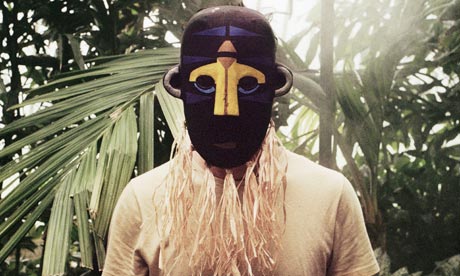Tim Jonze's On shuffle: dubstep

More space than bass ... SBTRKT
The plan was simple: spend a month immersing myself in the world ofdubstep and try to take the pulse of what's happening right now. There was just one problem: whenever I ventured into the genre's forums and low-frequency sounds, I kept bumping into people who said it was dead. And it's hard to take the pulse of something that's dead.
When I say "dead", what I mean – of course – is that it's topping the charts, selling out arenas, putting out compilations (here comes 100% Pure Dubstep Vol 2), conquering America and shaping some of the biggest modern pop records around (Rusko, for instance, has worked with Britney and Rihanna). It's a kind of "dead" that most people could live with. It's far from unusual to run into a post on dubstepforum.comalong the lines of "I got into dubstep through Benga, Skream etc … now it's all heavy wobble shit with lame-ass gangsta rap samples." Or there's the view held by Jamie Teasdale, a former dubstep producer better known by the moniker Vex'd: "There's this burden of structure and expectation around dubstep these days and that's become a bit repellent to a lot of people," he says. "The very aggression and commercialness of it."
This straitjacketing of creativity was a problem encountered by another genre over 30 years ago – punk. No sooner had punk exploded into the mainstream, it seemed suddenly tired and bereft of new ideas; the result being lots of bands playing the same three chords, dressed in the same studded jackets and shouting "oi" a lot. And just as post-punk emerged to offer a way forward, so a term that's been springing up rather a lot this year is "post-dubstep". You know the name has legs because it makes anyone remotely associated with it want to break things.
So what do these post-dubstep artists have in common? At the extreme ends, not a lot – the bombastic stadium synths of Joker's forthcoming single Here Come The Lights, for instance, have little to do with the dislocated, disorienting sounds of his 4AD labelmate Zomby.
Yet for many artists – Jai Paul, Jamie xx, Mount Kimbie – there seems to be a shift of emphasis away from rearranging your kidneys with piledriving bass and more towards toying with your emotions instead (not for nothing did the term "blubstep" spring up). SBTRKT's self-titled debut album, which came out earlier this year, will almost certainly end up as my favourite album of 2011. Dubstep isn't the overriding influence here. In fact, the first things that strike you about the album are the soulful vocals of Sampha – whose voice does "hurt" better than a wounded puppy – and its deft, garage-inspired rhythms. Yet SBTRKT's use of space rather than sub-bass shows he at least understands what was so special about early dubstep. What makes SBTRKT post-dubstep, however, is similar to what made artists "post-punk". It's less about some unifying sound, more a keenness to look beyond the rigid structures of one genre and embrace sounds from elsewhere; from R&B and indie to house, garage and grime.
Post-dubstep threads are often concerned with artists who've previously dabbled in dubstep but have long since flown off on bizarre tangents – one such being Rustie, whose debut album Glass Swords is due next month on Warp. One track, Ultra Thizz, has fans on Soundcloud posting things like "head asplode" and "skull fukt" thanks to its onslaught of mangled chipmunk vocals, ricocheting synth stabs, rapidly accelerating rhythms and gurgling bass. It doesn't sound like an explosion in a Game Boy factory – that would just be a big bang – but it's what it would sound like in an ideal world. It's an intense listen, but then if you're looking for delicate subtlety from the man who once penned a track called Inside Pikachu's Cunt then you're probably the kind of listener disappointed at the lack of winsome ballads on the new Cerebral Ballzy record.
The aforementioned Jamie Teasdale is also making a contribution. Operating now as Kuedo, next month sees Planet Mu release his debut album, Severant. Despite his past, Teasdale sees few – if any – connections between the scene and the Vangelis-like waves of synths, hip-hop-inspired beat patterns and classical flourishes of Severant. "I haven't listened to any classic dubstep in years, and I've taken no intentional influence from it," he says. Instead, he believes that "dubstep has become a catch-all term for anything that's got certain elements; so if it's not intentionally fast or it has a predominant sub-bassline, it's de facto dubstep."
Far from being dead, dubstep has become established enough to become a pervasive influence in music. Such variety points to a bright future, just so long as nobody does anything as stupid as start mentioning "post-dubstep" in places like, say, The Guide. As Teasdale says with a smile: "Anyone with any sense who hears that term would shriek in terror."
No comments:
Post a Comment